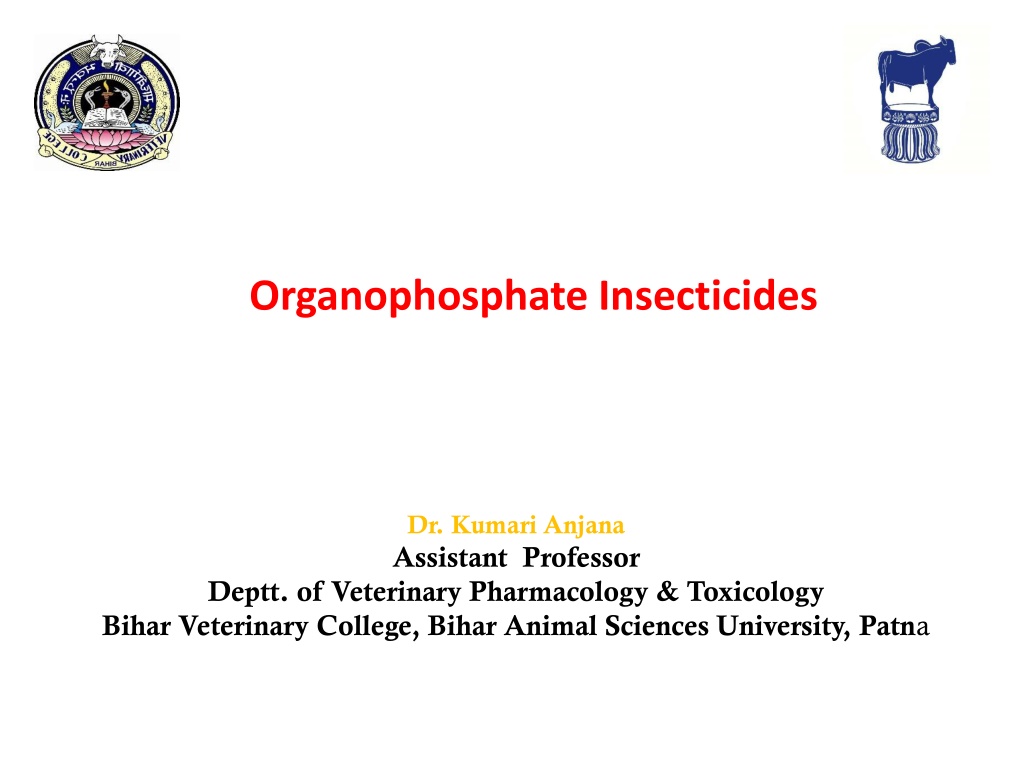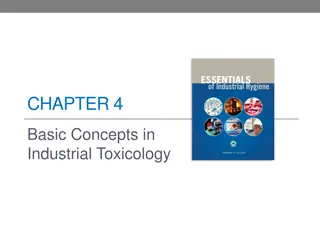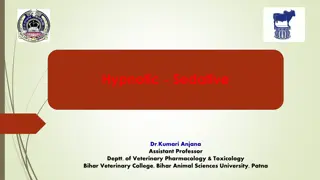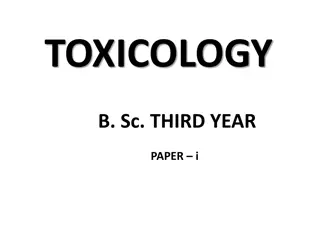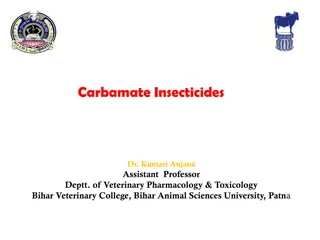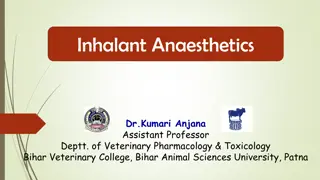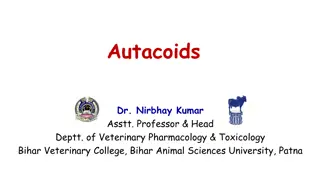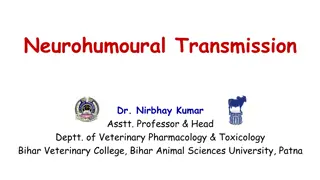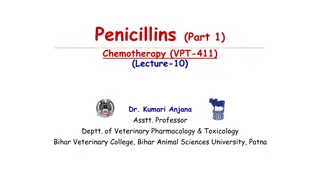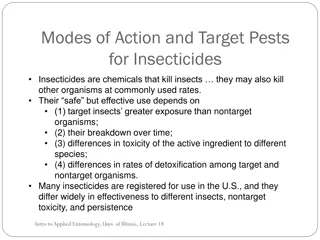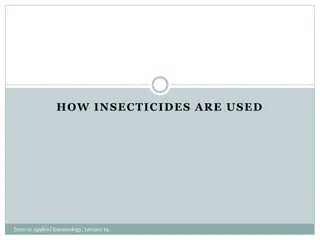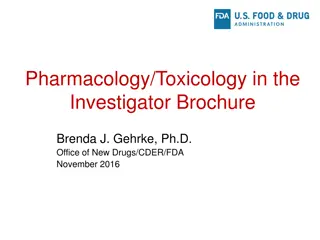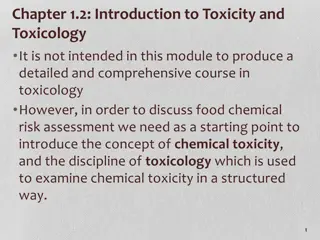Understanding Organophosphate Insecticides in Veterinary Pharmacology & Toxicology
Organophosphate insecticides, discussed by Dr. Kumari Anjana, Assistant Professor at Bihar Veterinary College, have a significant impact in controlling pests. These compounds inhibit cholinesterase enzymes, and their uses span across various applications including insecticides, acaricides, and herbicides. Compared to organochlorins, organophosphates are more biodegradable but acutely toxic. The history, structure, and classification of these compounds provide insights into their mechanisms of action and clinical implications.
Download Presentation

Please find below an Image/Link to download the presentation.
The content on the website is provided AS IS for your information and personal use only. It may not be sold, licensed, or shared on other websites without obtaining consent from the author. Download presentation by click this link. If you encounter any issues during the download, it is possible that the publisher has removed the file from their server.
E N D
Presentation Transcript
Organophosphate Insecticides Dr. Kumari Anjana Assistant Professor Deptt. of Veterinary Pharmacology & Toxicology Bihar Veterinary College, Bihar Animal Sciences University, Patna
Content of the chapter Introduction Uses Comparison to organochlorine compounds History Classification Differences from direct acting OP compounds indirect acting OP compounds Mechanism of action Clinical signs Diagnosis Treatment
Introduction OP compound are esters of phosphoric, phosphonic, phosphorothioic or related acids which have ability to inhibit cholinesterase enzyme.
USES As insecticides, organophosphates are one of the major groups in use in present time: Insecticides, Acaricides, Soil nematodes, Fungicides, Herbicides, Defoliants, Rodenticides, Insecticide synergists, Insect repellents, chemosterilants and Warfare agents.
Compared to Organochlorins OPs are: Much less environmentally persistent, Much more biodegradable, Less subject to biomagnifications, Usually unstable in presence of sunlight. However, compared to organochlorins, they are much more acutely toxic to non-target species and several cases of poisoning frequently occur in man, domestic animals and wild life. Although most OPI are not very persistent in environment and dissipate in 2-4 weeks, some OPs, such as chlorpyriphos, are sufficiently persistent to be used for control of termites.
History 1st OPI - tetraethyl pyrophosphate (TEPP). Developed in Germany during Second World War as a substitute for nicotine. This was followed by tabun and sarin. These compounds were highly toxic to mammals and were rapidly hydrolysed by moisture. This led to the discovery by Schrader in 1944 of more stable compound parathion and its oxygen analogue paraoxone.
The general structure of OP insecticides is given by the formula. where , R: alkyl, aryl, alkoxy, alkylthio or amino group. The X is an acid radical, which may carry various substituents, particularly electron- withdrawing groups. It is called a leavinggroup because it may leave by disruption of P-X bond.
Classification of OPI Based on chemical structure Phosphate & pyrophosphate- Paraoxon, tetraethyl Phosphorothioates - Parathion, fenthion, diazinon, runnel Phosphonates - Trichlorphon Phosphoramidates- Phospholan, mephospholan Phosphorothiolates- Echothiophate, profenophos Phosphorohalides- Diisoprophylfluorophosphate (DFP), sarin Phosphorocyanides- Tabun. pyrophosphate (TEPP), schraden, dichlorvos.
Based on mode of action (Classification) Direct acting OP insecticides These insecticides contain P=O group. So, they directly inhibit cholinesterase enzyme and produce toxicity. TEPP, trichlorphon and dichlorvos. Indirect acting OP insecticides These insecticidesare basically phosphorothioates containing P=S groups. Sulphur is not electrophilic so, such compounds are inactive as anticholinesesterases. These agents activation to oxon (conversion of P=S moiety to a P =O moiety) in the body. Malathion, parathion fenthion. require and
Mechanism of action OPI owe their toxicity by irreversible inhibition of AChE enzyme, which is responsible for hydrolytic degradation of acetylcholine (NT released at cholinergic synapses). This leads to Ach accumulation in nerves and neuro-effector junctions, which causes excessive synaptic neurotransmitter parasympathetic nervous neuromuscular sites and affected animals show parasympathetic or chlolinergic signs. activity system in and the at
MOA of AChE inhibition by OP compounds closely resembles the catalytic hydrolysis of Ach but, unlike Ach, OP compounds interact with only the active esteric site of the enzyme and the enzyme OP complex formed is extremely stable that does not undergo significant spontaneous hydrolysis. Restoration of acetylcholinesterase activity often requires synthesis of new enzyme molecule that may take several weeks. In initial stages, some spontaneous hydrolysis may occur (mostly negligible) or complex can be dissociated with the use of chemical agents called cholinesterase enzyme reactivators like pyridine-2-aldoxime.
However once covalent modification of enzyme occurs and the phosphorylated enzyme looses one of its alkyl group (called aging), it is impossible for chemical reactivators to break the bond between the inhibitor and the enzyme. Aging is very rapid for nerve gases. soman (aging half life 2 minutes), less for DFP (approx. 4 hrs) and more (up to 36 hrs) for many other OPI.
Phosphorylation of AChE enzyme occurs when organophosphate occupies esteratic site of the enzyme. Spontaneous hydrolysis resulting in regenerated enzyme may occur poorly. When aging occurs (loss of esterified moiety R ), recovery of cholinesterase does not occur due to formation of irreversible stable bonds. This needs synthesis of new enzymes.
In addition to acetylcholinesterase enzyme (also called true cholinesterase), OPI inhibit plasma cholinesterase (also called pseudocholinesterase or butyryl cholinesterase), a non specific enzyme, and some other esterases with serine residue at active sites called as neurotoxic esterase. Inhibitions of these non-specific enzymes may interfere with metabolism of a wide variety of esters that occur in plasma, nervous tissue and some other systems in the body.
Some OPI like tri-ortho cresyl phosphate (TOCP), diisopropyl phosphorofluoridate (DFP), EPN (Ethyl nitrophenyl phosphonothioate), leptophos, mipafox . produce These compounds are weak ChE inhibitors but strongly inihibit neurotoxic esterase (NtE) in brain and spinal cord causing axonal swelling, breakdown and demyelination of spinal and peripheral neurons.
The signs of delayed neurotoxicity include muscle weakness, ataxia, flaccid paralysis of limbs. Poultry birds are the most sensitive spp. This delayed toxic organophosphorus induced delayed neuropathy (OPIDN) or dying back axonopathy (so called because it starts at periphery and then goes upward into spinal spinocerebellar, vestibulospinal and other tracts). Larger diameter fibres appear to be more affected then small diameter fibres. axonopathy is called cord and up into
Clinical sign Muscarinic signs: Profuse salivation (watery drooling), bronchial secretions and constriction, diarrhoea, frequent urination and miosis.
Nicotinic signs: Muscular tremors, convulsions, paralysis of respiratory muscles and dyspnoea. CNS signs: Restlessness, ataxia, depression of respiratory and vasomotor centres, paralysis, coma and death due to respiration failure followed by cardiovascular failure.
Diagnosis History, circumstantial evidence, Clinical signs, Estimation of blood ChE activity (25% or more decrease in OPI and carbamate toxicity) Identification of the insecticide in feed, water, ruminal content or tissues.
Treatment Specific antidotes: a) Muscarinic blockers b) ChE reactivators Reduce absorption Atropine SO4: Dogs and Cats: 0.2-2 mg/kg 1/ iv and rest sc. Repeat every 3-6 hr as required. Horse and Pig: 0.1-0.2 mg/kg I/V, repeat every 10-15 min as needed; Cattle and sheep: 0.5-1 mg/kg 1/3 iv and rest im or sc, repeat as needed. Over dosage of atropine to be avoided.
2-PAM (2-Pyridine aldoxime methiodide, 2-PAM chloride) @ 20-50 mg/kg as 10% sol im or slow iv (if rapid respiration arrest) repeat if necessary. ChE activation decreases with time (after exposure), better to use within 24-48 hr. If ingestion: Emetics, purgatives, activated charcoal (3-6 g/kg as slurry in water. If dermal: wash with soap and cool water.
